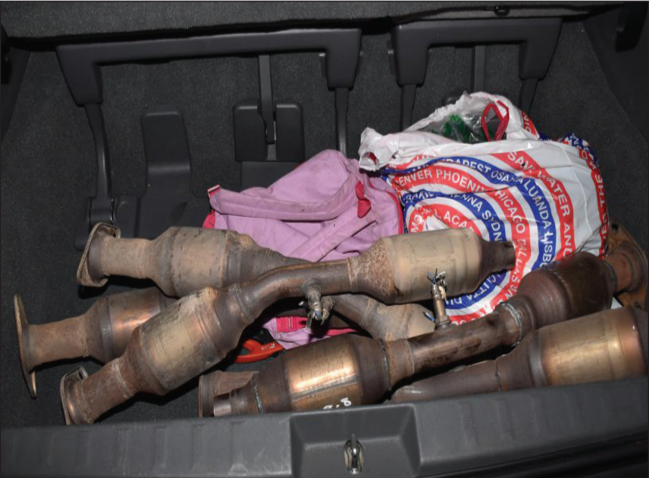“This can’t be right,” thought Isabel, a local college student, when she turned on her car after work this past November. A deafening roar erupted from the 2003 Honda Accord, and “it smelled like smoke, or like something burning.” Startled by the noise and the odor, she called for a tow truck. When the driver arrived, he promptly diagnosed the clamor coming from under her automobile.
“He turned it on himself and immediately was like, ‘Oh, yeah, they stole your catalytic converter,’” Isabel said.
The Honda was deemed totaled on the spot. Her experience is not unique. Catalytic converter thefts are on the rise across the nation, and Ventura County is no exception.
Mechanic and owner of American Muffler, Brake & Radiator in Thousand Oaks, Dirk Levens, says it’s the precious metals inside the converters that make them such a lucrative steal. Rhodium, palladium and platinum, toxin-reducing metals, are yielding a pretty penny on the black market. The cost of rhodium is averaging around $15,000 per troy ounce, dwarfing its 2018 average of $2,050 per ounce.
Increasing tariffs on foreign manufacturers, unstable trade relations with China, and environmental policies all play a part in inflating the price of these metals — increasing the frequency of these thefts. Local law enforcement has observed an upsurge since 2020 and especially in the last twelve months. Since November 2021, there have been more than sixty thefts and attempted thefts in Thousand Oaks alone.
‘It sounds like a tank’
While thieves sell stolen converters illegally for several hundred dollars, the financial damage to owners is far greater. Levens, who has been in the muffler and catalytic converter business for more than forty years, says replacement costs can be “anywhere between $1,000 and $3,500, depending on the damage and how many other parts have to be replaced. … Sometimes the cost of the job is more than the car is worth.”
Thieves spot a vulnerable car in a parking lot or prowl neighborhoods for a solitary automobile to slide under. Isabel’s car was in a well-lit parking lot equipped with security cameras. Still, no footage could identify the perpetrator(s), who were not deterred by the high-traffic location or the fact that it was the middle of the day.
In a matter of minutes or even seconds, thieves use battery-powered saws to cut through the metal connectors. Most people don’t notice the part is missing until they turn the car on. Then, the cacophony is unmistakable.
“It sounds like a tank because the pipes are no longer hooked up to the muffler, which quiets the car down,” Levens explains.
If you hear that telltale sound, don’t drive the automobile, he warns.
“It’s loud as can be and really not safe to drive at times because the exhaust can damage some other parts underneath the car.”
Possible solutions
Anti-theft devices on the market include shields, alarms and cut-resistant straps. Though not a cure-all, these products can prevent automobiles from becoming easy targets. Toyota features “a full line of them for the Priuses because those seem to be the most popular ones to steal,” said Levens. Ford F250s, Honda Elements, Ford F350s, and Honda Accords also rank high on thieves’ hit lists.
The Ventura County Sheriff’s Office also is finding innovative ways to combat this noisome — and costly — trend. In March 2021, TOPD launched its “Etch and Catch” program in collaboration with local businesses.
“We’re inscribing a little sheriff’s insignia on there, and we’re inscribing the vehicle’s VIN (vehicle identification number) or the plate on the actual catalytic converter,” senior deputy Rob Brady told the Guardian. Nine automotive businesses throughout the Conejo Valley are participating in the program, offering free etching for vehicles.
Officers recommend parking vehicles in a garage if possible or in a driveway. Cameras or motion-sensing lights may also deter thieves. Anything that slows them down helps, too, because, for thieves, speed is the key.
The purpose, Brady says, is twofold: case-building and theft deterrence. If a stolen catalytic converter is found with the VIN or plate etched into it, law enforcement can trace it back to the owner. Then they can “move forward with a case” to convict thieves.
“Sometimes patrol will stop a vehicle, and there are a few catalytic converters in there, and there’s no way to trace where they came from,” explains Brady. “It’s better to file a case with an actual victim than just a random piece of stolen property.”
The Moorpark Police Department introduced the Etch and Catch program to Ventura County back in February 2021. Since then, the model has spread throughout the county and the state.
“It’s caught on,” Brady says. “A lot of different agencies in California are doing it.”
Several arrests have been made since the start of the program in Thousand Oaks, and Brady is optimistic that more will follow. He credits officers patrolling “the right areas” and “the community being more vigilant” for their success in apprehending perpetrators.
“If [people] are hearing a saw at two in the morning,” he says, “I think most of the public knows about this, and they’re actually calling us, and we’re able to respond a lot faster.” Brady says that there are “some brazen ones that happen in broad daylight,” as in Isabel’s case, “but most of them are early, early morning hours.”
Brady and Levens also recommend parking vehicles in a garage if possible or in a driveway. Cameras or motion-sensing lights may also deter thieves. Anything that slows them down helps, too, because, for thieves, speed is the key.
“They want to get in and out of there in under a minute,” says Brady.

